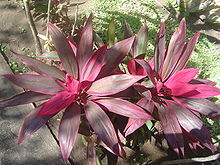Loading AI tools
Genus of flowering plants From Wikipedia, the free encyclopedia
Cordyline is a genus of about 24 species of woody monocotyledonous flowering plants in family Asparagaceae, subfamily Lomandroideae. The subfamily has previously been treated as a separate family Laxmanniaceae,[2] or Lomandraceae. Other authors have placed the genus in the Agavaceae (now Agavoideae). Cordyline is native to the western Pacific Ocean region, from New Zealand, eastern Australia, southeastern Asia and Polynesia, with one species found in southeastern South America.
| Cordyline | |
|---|---|
 | |
| Cordyline fruticosa | |
| Scientific classification | |
| Kingdom: | Plantae |
| Clade: | Tracheophytes |
| Clade: | Angiosperms |
| Clade: | Monocots |
| Order: | Asparagales |
| Family: | Asparagaceae |
| Subfamily: | Lomandroideae |
| Genus: | Cordyline Comm. ex R.Br.[1] |
| Species | |
|
See text | |
| Synonyms | |
| |
The name Cordyline comes from the Greek word kordyle, meaning "club," a reference to the enlarged underground stems or rhizomes.[3]
As of March 2015[update], the World Checklist of Selected Plant Families accepted 24 species:[4]
Members of the group are often grown as ornamental plants - notably C. australis and C. fruticosa. Many species have been used as a foodstuff and medicine, for additional details on these and other uses see the article on C. australis. The rhizome was roasted in an hāngī (earth oven) by Māori to extract sugar.[6]
In the highlands of Papua New Guinea. leaves of Cordyline and other plants are tied to sticks to mark taboo areas where pandanus language must be spoken during karuka harvest.[7]
Seamless Wikipedia browsing. On steroids.
Every time you click a link to Wikipedia, Wiktionary or Wikiquote in your browser's search results, it will show the modern Wikiwand interface.
Wikiwand extension is a five stars, simple, with minimum permission required to keep your browsing private, safe and transparent.